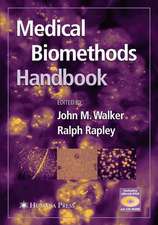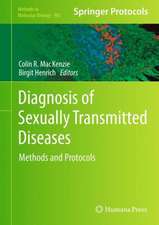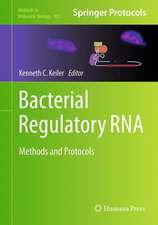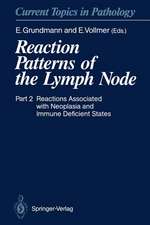Epstein-Barr Virus and Human Disease · 1990: Experimental Biology and Medicine, cartea 24
Editat de D. V. Ablashi, A. T. Huang, J. S. Pagano, G. R. Pearson, C. S. Yangen Limba Engleză Hardback – 11 noi 1991
| Toate formatele și edițiile | Preț | Express |
|---|---|---|
| Paperback (1) | 1105.61 lei 6-8 săpt. | |
| Humana Press Inc. – 5 noi 2012 | 1105.61 lei 6-8 săpt. | |
| Hardback (1) | 1112.70 lei 6-8 săpt. | |
| Humana Press Inc. – 11 noi 1991 | 1112.70 lei 6-8 săpt. |
Din seria Experimental Biology and Medicine
- 15%
 Preț: 654.77 lei
Preț: 654.77 lei - 5%
 Preț: 738.20 lei
Preț: 738.20 lei - 5%
 Preț: 1434.04 lei
Preț: 1434.04 lei - 5%
 Preț: 1430.35 lei
Preț: 1430.35 lei - 5%
 Preț: 727.24 lei
Preț: 727.24 lei - 18%
 Preț: 1242.21 lei
Preț: 1242.21 lei - 5%
 Preț: 1435.85 lei
Preț: 1435.85 lei - 18%
 Preț: 1225.28 lei
Preț: 1225.28 lei - 5%
 Preț: 719.59 lei
Preț: 719.59 lei - 5%
 Preț: 1422.67 lei
Preț: 1422.67 lei - 18%
 Preț: 1215.36 lei
Preț: 1215.36 lei - 18%
 Preț: 1239.67 lei
Preț: 1239.67 lei - 5%
 Preț: 1423.95 lei
Preț: 1423.95 lei - 18%
 Preț: 1222.49 lei
Preț: 1222.49 lei - 18%
 Preț: 1239.49 lei
Preț: 1239.49 lei - 5%
 Preț: 727.44 lei
Preț: 727.44 lei - 5%
 Preț: 786.29 lei
Preț: 786.29 lei - 5%
 Preț: 1423.95 lei
Preț: 1423.95 lei - 5%
 Preț: 729.82 lei
Preț: 729.82 lei - 18%
 Preț: 959.19 lei
Preț: 959.19 lei - 18%
 Preț: 1236.51 lei
Preț: 1236.51 lei - 5%
 Preț: 1113.63 lei
Preț: 1113.63 lei - 15%
 Preț: 644.18 lei
Preț: 644.18 lei - 18%
 Preț: 1240.93 lei
Preț: 1240.93 lei
Preț: 1112.70 lei
Preț vechi: 1171.25 lei
-5% Nou
Puncte Express: 1669
Preț estimativ în valută:
212.94€ • 221.49$ • 175.80£
212.94€ • 221.49$ • 175.80£
Carte tipărită la comandă
Livrare economică 14-28 aprilie
Preluare comenzi: 021 569.72.76
Specificații
ISBN-13: 9780896032217
ISBN-10: 0896032213
Pagini: 455
Ilustrații: XLIV, 455 p.
Dimensiuni: 155 x 235 x 27 mm
Greutate: 0.88 kg
Ediția:1991
Editura: Humana Press Inc.
Colecția Humana
Seria Experimental Biology and Medicine
Locul publicării:Totowa, NJ, United States
ISBN-10: 0896032213
Pagini: 455
Ilustrații: XLIV, 455 p.
Dimensiuni: 155 x 235 x 27 mm
Greutate: 0.88 kg
Ediția:1991
Editura: Humana Press Inc.
Colecția Humana
Seria Experimental Biology and Medicine
Locul publicării:Totowa, NJ, United States
Public țintă
ResearchCuprins
I. Molecular Biology of EBV.- Replication of the Epstein-Barr Virus in Lymphoid and Epithelial Cells.- The Productive Cycle Defect in Raji EBV is Not Solely Due to Absence of the BALF2 Gene.- Interference of EBNA-1 Binding to ori -P by Cellular Proteins (Anti-EBNA1).- How ZEBRA, a Weak Transactivator, Exerts Strong Biologic Effects.- EBNA-2 Transactivation of CD23.- EBNA-2 Transactivation of LMP1.- A New Lymphoid-Specific Epstein-Barr Virus Enhancer Is Transactivated by EBNA-2.- Transcriptional Regulation of an Epstein-Barr Virus Nuclear Antigen Gene Promoter.- EBNA-2 Influences Promoter Function in Burkitt Lymphoma Cells.- Functional Characterization of Epstein-Barr Virus DNA Polymerase by In Vitro Transcription-Translation of Cloned Genes.- Epstein-Barr Virus Recombinants: Use of Positive Selection Markers to Rescue Mutants in EBV Negative B Lymphoma Cells.- Characterization of EBV DNase Related Transcripts.- The PstI- Repeats of the Epstein-Ban Virus Encode a Protein with a Molecular Weight between 115,000 and 140,000.- The EBV BRLF1 Protein Has Sequence and Functional Similarity with the C-myb Oncogene.- Heterodimers of the ZEBRA and fos Basic Domains Bind DNA with the Specificity of ZEBRA.- Relationship of the EBV Lytic Activator Zta to the bZIP Family of Cellular Transactivators.- Trans-Regulation of the Early MS Gene of EBV and Its Depen-dence on the Host Cell.- Induction and Regulation of Expression of the Epstein-Barr Virus DNA Polymerase Gene.- Recombinant EBV Antigens and Their Diagnostic Value.- Epstein-Barr Virus Associated Histio-Lymphoproliferative Syndromes in Two European Families.- II. Pathobiology of EBV.- Role of Cytokines in EBV-Infected Cell Growth.- Epstein-Barr Virus Variants at Mucosal Surfaces.- Epstein-Barr Virus Infection and Monokine Synthesis.- Transcription from Bam HI A in NPC.- Characterisation of the Novel “18.8” Family of Transcripts from NPC Tumours.- EBER1 Small Nuclear RNA in Malignancy: A Morphologically Distinctive Target for Detection of EBV in Formalin-Fixed Paraffin-Embedded Specimens.- Tumorigenicity and Organization of the Terminal Region of the Epstein-Barr Virus (EBV) Genome in LCLs Derived from Carcinogen-Treated Lymphocytes.- Expression of EBNA2 and an EBNA5 Protein from Alternatively Spliced mRNA’s.- III. Immunology of EBV.- EBV Humoral Immunology: 1966-1990.- The Role of EBNA Proteins as a Target for EBV-Specific T Cell Lysis.- Role of the Epstein-Barr Virus (EBV) Glycoprotein gp350 as a Target Antigen for EBV-Specific Cellular Killing.- Mapping of B and T Cell Epitopes on the Epstein-Barr Virus Receptor Ligand gp340: A Candidate Subunit Vaccine.- Identification of T Helper Cell Epitopes on gp 340.- Reactivity of EBV Type A-Specific Cytotoxic T-Cells.- DNA Sequence Variation in EBV-Encoded T-Cell Epitopes.- Recombinant Adenoviruses Which Express the EBV Major Membrane Antigen gp340/220 Induce Persistent EBVNeutralizing Antibodies in Rabbits.- Inhibition of the EBV Lytic Cycle by Sequence Specific Antisense Oligonucleotides.- IV. EBV Associated Lymphoproliferative Disorders.- Advances in the Understanding of EBV Associated Lympho-proliferative Disorders.- The Association of Epstein-Barr Virus with Lymphoproliferative Disorders: A Re-Evaluation Using the Polymerase Chain Reaction.- Absence of EBV in Reed-Sternberg Cells in Many Cases of Hodgkin’s Disease.- EBV and Granular Lymphocytes Proliferation.- EBV Transmission and Expression Among Patients with PTLD.- SCID Mouse Model of Virus-Induced Lymphomagenesis of Immunodeficient Humans.- Patients with Psoriasis Have High SerumReactivity with EBNA2B.- EBV Activation by Anti-IgG-Triggered, Second Messenger Pathways.- V. Advances in NPC.- Nasopharyngeal Carcinoma:1990.- In Situ Analysis of Epstein-Barr Viral Expression in Nasopharyngeal Carcinoma.- Interaction of EBV Genes with Human Epithelial Cells.- Studies on the Terminal Protein I (TP1) of the Epstein-Barr Virus and the Anti-TP Immune Response in Humans.- Diagnosis of Nasopharyngeal Carcinoma Using the Epstein-Barr Virus Coded Alkaline DNase Membrane Antigen and Thymidine Kinase.- Detection of Anti-Epstein Barr Virus Transactivator (ZEBRA) Antibodies in Sera from Patients with Nasopharyngeal Carcinoma.- EBV pp58 DNase Expressed in the Baculovirus System May Improve the Diagnosis of NPC.- Efficacy of Exfoliative Cytology in Diagnosis of Nasopharyngeal Carcinoma.- Neoadjuvant Approach with Bleomycin, Epirubicin and Cisplaten in the Treatment of Locally Advanced UCNT.- VI. Clinical Aspects of NPC.- Pathogenesis of Nasopharyngeal Carcinoma.- EBV Genome Oranization in Lymphoblastoid Cell Lines Established Following Enhancement with Aflatoxin B1 and Relevance to Nasopharyngeal Carcinoma.- Preliminary Results of HLA Class I and Class II Antigens in Chinese with Nasopharyngeal Carcinoma.- Radiation Therapy of Nasopharyngeal Cancer in Taiwan University Hospital 1958-1989.- 417 Chemotherapy in Undifferentiated Type Nasopharyngeal Carci-noma (UCNT).- Neoadjuvant Chemotherapy Plus Radiotherapy Versus Radiotherapy Alone in Nasopharyngeal Cancer.- The Role of Surgery in the Management of Recurrent Primary Nasopharyngeal Carcinoma.- Randomized Controlled Studies on Immunotherapy of Nasopharyngeal Carcinoma with OK-432.- A Preliminary Study on the Immunogenicity in Rabbits and in Human Volunteers: Recombinant Vaccinia Virus Expressing Epstein-Barr VirusMembrane Antigen.- List of Participants.
Recenzii
...can be recommended as containing a wealth of source material, not otherwise easily accessible.-Reviews in Medical Virology
























